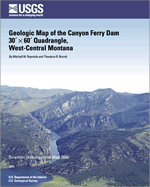
The geologic map of the Canyon Ferry Dam 30' x 60' quadrangle, west-central Montana, portrays the geology of an area of about 4,200 km2, extending from near the capital city of Helena east about 74 km and about 55 km from south to north. The area encompasses the scenic canyons of the Missouri River through the Gates of the Rocky Mountains and the Smith River through the west end of the Little Belt Mountains, and includes the eastern part of Helena Valley, the northern end of the Townsend Valley,
and the Smith River Valley. The quadrangle lies at the junction of four major tectonic elements: the Montana disturbed belt, the Lewis and Clark
tectonic zone, the Boulder batholith and associated intrusive bodies, and the continental autochthon. Basin and range structures overprint
those tectonic elements. Rocks and sediments across the area are assigned to 129 map units that range in age from Paleoproterozoic (1.6-2.5 B.Y.)
crystalline rocks to historic dredge deposits. Mesoproterozoic through Cretaceous rocks in the northwestern part are complexly deformed at the
south end of the Montana disturbed belt, a tectonic belt that terminates by detachment along an Upper Mississippian evaporite deposit from
underlying older rocks of the continental autochthon. Late Cretaceous and Eocene igneous rocks intrude older rocks in the southwestern and
northeastern parts of the quadrangle, and Oligocene basalt flows and plugs are present mostly across the northern part. Oligocene and Miocene
strata, broken by Miocene and younger normal faults, are exposed in the major valleys. Quaternary deposits, including stream, glacial and glacial
lake, landslide, and other mass wasting deposits, lie on surfaces eroded across all the older rocks. An accompanying pamphlet describes the units
and discusses highlights of the stratigraphy and geologic structure.
Version 1.0
|
| Posted May 2005 |
| Part or all of this report is presented in Portable Document Format. The latest version of Adobe Acrobat Reader or similar software is required to view it. If you wish to download the latest version of Acrobat Reader free of charge, click here.
|
Downloading Suggestion:
It is best to download a large PDF file to your hard drive rather than open
it inside your browser. (A standard click may automatically open the PDF file
inside the browser but doing so will result in a very slow load.) For guidance
on how to do this, go to [http://cpg.cr.usgs.gov/toolbox/download_advice.html].
Downloading the PDF file may take several moments but will be worth the wait. Once it is downloaded, open the PDF from your hard drive using
Adobe Acrobat—it will open in a fraction of the time it would take to open the PDF over
the Internet.
|

